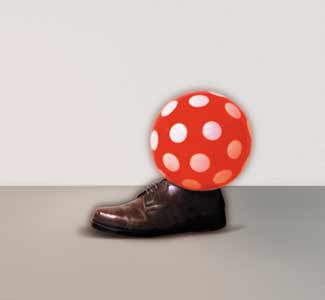 |
A decisive feature of today’s art
is versatility. The boundaries between genres can be transgressed, artists
often work in several different fields to approach the question of how
to mediate their message from several directions simultaneously. This open
attitude is aptly exemplified by Pál Gerber. As a painter, he does
not rest content with the visual forms of two-dimensional expression but
expands his work to include texts and installations. He does exclusively
show his works in exhibition galleries but often uses other non-traditional
sites such as on the sides of buses or on postal stamps.
As for his motifs, the viewer is inclined to discover
a sort of interrelated symbolism in his works in which the objects are
often linked together in a method much like that of Renaissance emblems.
His installations, however, nearly always consist of everyday objects (the
chair, ax, stag, house, spoon, plate), whose meanings are much more ambiguous.
The manner in which he applies even symbols that contain traditional connotations
(the sword or cross), often serves to thwart or confuse our interpretations.
His pictures are like difficult puzzles, but in his words they can also
be interpreted as "the oddest" arrangement of the most ordinary things.
An important element in understanding his approach is to recognise the
both visual and verbal humour present within his work. In this context,
his puns may remind one of Wittgenstein’s observation of the truth contained
within slips of the tongue; ironic or "funny" sentence arrangements may
be similar to painted ensembles of objects placed into an "odd" context.
His art exists within a contemporary Hungarian culture characterised by
a conceptually grounded yet profound thinking; it accepts both irony and
simplicity, forms of representation that endow the "everyday" with meaning.
Zsolt Petrányi |